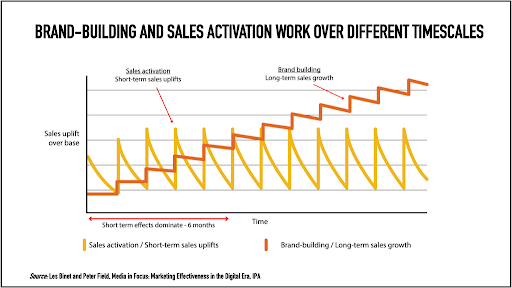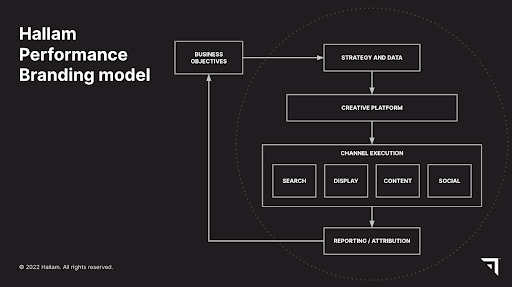At times, marketing has to respond to seismic changes in society, like new technologies or widespread reversals in customer attitudes and behaviour. Other times, we have to respond to more subtle shifts – though they’re no less important.
Like a puzzle whose picture only emerges as you bring the pieces together, I believe we’re in the midst of one of these subtle reorderings: an evolution that precedes a big leap forward.
The individual pieces coming together include data, advances in marketing technology, a better understanding of distribution channels, developments in understanding customer attention, better ways to measure our activity and more.
We didn’t coin the term Performance Branding, but we believe it’s the best way to talk about the confluence of ideas and technology that make a new approach to marketing possible. And while it may not sound transformational, if we truly grasp what the concept entails and apply it in practical ways across our marketing activity, I think we’ll see huge returns for brands.
Why we need a fresh approach to marketing
Over the past several decades, marketing has been siloed into two distinct – and separated – activities: Brand Marketing and Performance Marketing.
- Brand Marketing is about laying the foundations for tomorrow’s demand.
- It works over a longer period of time, often 6+ months with bigger impacts being seen in years two and three
- It is human-focused and emotive, using storytelling to bring the values of the brand to life
- It’s about building positive perceptions of the brand and creating memory structures in the brain that link the brand to a buying situation
- Performance Marketing is about capturing today’s demand.
- It works in the short term – today, this week, this month
- It’s often product-led and rational, using data to drive the targeting and messaging choices
- It prioritises action – it wants leads, sales, sign ups, whatever a conversion is for the brand – at the most efficient cost
Too often, these activities are owned by different teams within the same company and almost certainly use different agency partners. They compete with each other for senior level support, budgets and at times have conflicting objectives.
Unfortunately, running these efforts in isolation leads to:
- Inconsistencies across the customer journey, resulting in a disjointed experience
- Higher acquisition costs and more customer church
- Ineffective activity that wastes time, effort and money
- Long-term stasis for the business rather than growth
The Long and Short of It
Les Binet and Peter Field’s famous chart shows how these two types of marketing activity work. 
Sales activation is about the short term capturing today’s demand. This is how Performance Marketing works – and it does work. You turn it on and get immediate responses, but when you turn it off, you get rapid decay.
Brand building takes more time to have an impact and it’s harder to do, but the effects last longer and accumulate over time. It’s about creating tomorrow’s demand. Brand Marketing changes preferences and habits over the long term.
It’s important to remember that Brand Marketing delivers long-term growth, but it can’t deliver short-term results. Performance Marketing delivers quick, direct results but it won’t deliver long-term growth.
The only way to get ahead is to do both.
Performance Branding is located at the intersection of Performance Marketing and Brand Marketing – both are valid, both get results and both a role to play in the customer journey
How we define Performance Branding
Performance Branding is a full-funnel strategy that combines the emotional power of brand building with the precision of performance marketing. It links together five key elements – business outcomes, a holistic strategy, a big creative idea, intentional channel choices and a consolidated measurement framework – in a single-minded pursuit of growth.
Performance Branding delivers a seamless, consistent brand experience for customers wherever they are in their buying journey.
Using technology to gather, interpret and apply customer and market data in intelligent ways, Performance Branding makes your marketing investment work harder and more efficiently – leading to sustainable business growth.
Why Performance Branding works
There are several marketing principles that underpin the concept of Performance Branding, but let me point to the two most important ones. 
Mental availability is the extent to which a brand comes automatically to mind when a consumer finds themselves in a purchase situation. It’s a fundamental driver to marketing-led business growth.
And in fact, it drives all the important business metrics leaders care about. Mental availability and business outcomes are linked.
Because we work in digital marketing, we might think Google has primacy in people’s lives. But it isn’t true.
When we encounter that buying situation – when something happens to trigger a need or a want – the first search engine we turn to is our memory.
“The most important search engine is still the one in our minds.”
Jon Bradshaw, Brand Traction
It’s only when we can’t think of a product, service or brand to meet the need of the moment that we start exploring options through friends, family, online search engines or social media.
This is important because research from Ehrenberg-Bass shows that up to 95% of customers are not ‘in-market’ to buy your product right now. Of course, this will flex depending on your category and purchasing cadence but the principle holds true – there will always be more people in the category who are not ready to buy than those who are ready to buy.
So allocating the bulk of your budget and effort to convert that 5% today isn’t going to get you the long-term growth you want.
You need to be talking to those 95% so that when they’re ready to buy, your brand will be one of the ones they consider.
What does Performance Branding look like in practice?
I mentioned five key elements of Performance Branding above. These elements feed into each other in a sequential way, but they also form a feedback loop so that once you reach the measurement stage, those findings feed back into the first step of examining business performance.
Here are the five elements again:
- Clearly defined business outcomes that all the activity needs to deliver – this is the “performance” part of Performance Branding
- A full-funnel marketing strategy that links marketing activity to those business outcomes
- A creative brand platform that can have different applications across the entire customer journey
- Intentional channel choices that take into account the customer’s position in the funnel and their level of attention
- A measurement framework that ties it all together with clear attribution so you can see what’s working

There are a few more puzzle pieces that bring this to life. The first is data. This might be first-party customer data, qual or quant research you’ve done or secondary market research, but it’s a key part that informs our strategy. Marketing technology underpins the whole process and ties the activity together. And, finally, there needs to be a level of organisational maturity to think about and do marketing in this way.
If you want to learn more about how Performance Branding can help you get more impact from your marketing today, we’d love to hear from you.









